
Frisia is a cross-border cultural region in Northwestern Europe. Stretching along the Wadden Sea, it encompasses the north of the Netherlands and parts of northwestern Germany. The region is traditionally inhabited by the Frisians, a West Germanic ethnic group.
Friesland is a district (Landkreis) in Lower Saxony, Germany. It is bounded by the districts of Wesermarsch, Ammerland, Leer and Wittmund, and by the North Sea. The city of Wilhelmshaven is enclosed by—but not part of—the district.

Wilhelmshaven is a coastal town in Lower Saxony, Germany. It is situated on the western side of the Jade Bight, a bay of the North Sea, and has a population of 76,089. Wilhelmshaven is the centre of the "Jade Bay" business region and is Germany's main military port.
Wesermarsch is a Kreis (district) in the northwestern part of Lower Saxony, Germany. Neighboring are the districts of Cuxhaven and Osterholz, the city of Bremen in the state Free Hanseatic City of Bremen, the urban district of Delmenhorst, the district of Oldenburg and the urban district of Oldenburg, and the districts of Ammerland and Friesland.

The Frisian Islands, also known as the Wadden Islands or the Wadden Sea Islands, form an archipelago at the eastern edge of the North Sea in northwestern Europe, stretching from the northwest of the Netherlands through Germany to the west of Denmark. The islands shield the mudflat region of the Wadden Sea from the North Sea.

Nordenham is a town in the Wesermarsch district, in Lower Saxony, Germany. It is located at the mouth of the Weser river on the Butjadingen peninsula on the coast of the North Sea. The seaport city of Bremerhaven is located on the other side of the river. The Midgard-seaport in Nordenham is the largest private-owned harbor in Germany.
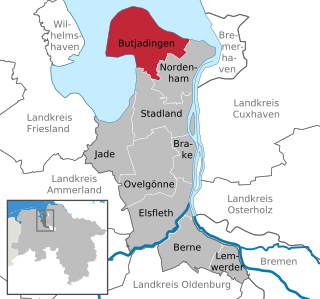
Butjadingen is a peninsula and municipality in the Wesermarsch district, in Lower Saxony, Germany.

The German Bight is the southeastern bight of the North Sea bounded by the Netherlands and Germany to the south, and Denmark and Germany to the east. To the north and west it is limited by the Dogger Bank. The Bight contains the Frisian and Danish Islands. The Wadden Sea is approximately ten to twelve kilometres wide at the location of the German Bight. The Frisian islands and the nearby coastal areas are collectively known as Frisia. The southern portion of the bight is also known as the Heligoland Bight. Between 1949 and 1956 the BBC Sea Area Forecast used "Heligoland" as the designation for the area now referred to as German Bight.

JadeWeserPort is Germany's largest harbour project. It is supported by the states of Lower Saxony and Bremen. This new container port is located at Wilhelmshaven at the Jade Bight, a bay on the North Sea coast. It has a natural water depth in excess of 18 m. Container ships with a length of 430 m and 16,5 m draught will be able to call the JadeWeserPort at any tide. Construction work was begun in March 2008. The port was opened on 21 September 2012. However, due to the Great Recession, the port wasn't given the warmest of welcomes, and very little TEU traffic flowed through the brand new harbour. But the container handling could be raised from 60,000 in 2014 to 426,700 twenty-foot equivalent unit in 2015. The yearly capacity of the port is 2,700,000 TEU.

The Heligoland Bight, also known as Helgoland Bight, is a bay which forms the southern part of the German Bight, itself a bay of the North Sea, located at the mouth of the Elbe river. The Heligoland Bight extends from the mouth of the Elbe to the islands of Heligoland and lies between the East Frisian island of Wangerooge and the North Frisian peninsula of Eiderstedt.
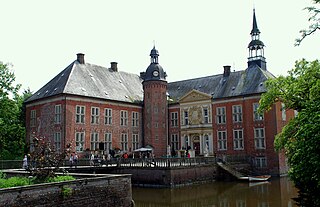
Sande is a municipality in the district of Friesland, Lower Saxony, Germany. It is situated near the Jade Bight, approximately 7 kilometres (4.3 mi) west of Wilhelmshaven, and 12 kilometres (7.5 mi) southeast of Jever.

Stadland is a municipality in the district of Wesermarsch, in Lower Saxony, Germany. It is situated on the left bank of the Weser, approx. 32 km northeast of Oldenburg, and 42 km northwest of Bremen. On the west side Stadland bordered to the Jade Bight. Its seat is in the village Rodenkirchen, which is also part of this municipality as the villages Schwei, Seefeld and Kleinensiel. There are also many little Bauernschaften (hamlets) in Stadland.

The Jade Treaty of 20 July 1853 between the Kingdom of Prussia and the Grand Duchy of Oldenburg provided for the handover of 340 hectares of Oldenburg territory at what is now Wilhelmshaven, Germany, on the western shore of the Jade Bight, a bay of the North Sea west of Bremerhaven. It was considered the best natural deep-water port in the German North Sea coast, and a good place for the naval base Prussia wished to build. The navy base built there became the nucleus of today's Wilhelmshaven.

The Weser Depression or Weser Lowlands is the region north of Porta Westfalica in Germany, where the River Weser no longer flows through a valley, but a broad plain consisting of meadows and river terraces.
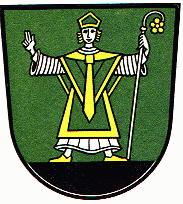
Land Hadeln is a historic landscape and former administrative district in Northern Germany with its seat in Otterndorf on the Lower Elbe, the lower reaches of the River Elbe, in the Elbe-Weser Triangle between the estuaries of the Elbe and Weser.
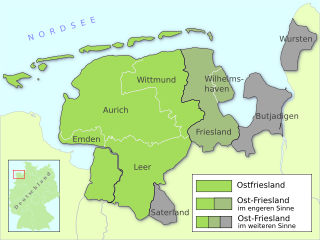
East Frisia is a collective term for all traditionally Frisian areas in Lower Saxony, Germany, which are primarily located on a peninsula between the Dollart and the Jade Bight. Along with West Frisia and North Frisia, it is one of the most commonly used subdivisions of Frisia.
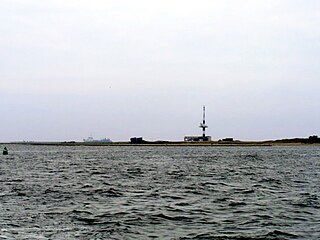
Minsener Oog, also Minser Oog or Minsener Oldeoog, is an uninhabited East Frisian island that belongs to the parish of Wangerooge in the north German district of Friesland in the state of Lower Saxony. It has been artificially enlarged through the construction of groynes.

John V, Count of Oldenburg and Delmenhorst was a member of the House of Oldenburg. He was the ruling Count of Oldenburg from 1500 to 1526. His parents were Gerhard VI, Count of Oldenburg and Adelheid of Tecklenburg.

Count John VII of Oldenburg and Delmenhorst was a member of the House of Oldenburg and was the ruling Count of County of Oldenburg from 1573 until his death. His parents were Count Anthony I of Oldenburg and Sophie of Saxe-Lauenburg.
Peasant republic is a term used to describe rural societies in the Middle Ages, especially in the Holy Roman Empire, in which royal, aristocratic and ecclesiastical power was unusually weak or non-existent, allowing the local farmers to enjoy a high degree of autonomy. In this context the term 'republic' does not necessarily imply the existence of the apparatus of a formal state, though this did exist in some such communities, but rather simply the absence of effective royal/princely power. Typically peasant republics were located in remote and inaccessible areas which were difficult for outside authorities to interfere in, and generally too poor to attract a lot of attention.





















